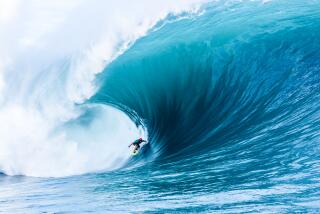Pro Surfers Catching Amazon’s Awesome Once-a-Year Wave
SAO DOMINGOS DO CAPIM, Brazil — Helio Noelio Sobrinho had been surfing for years off Brazil’s northern seacoast when he discovered The Wave. It was a surfer’s dream--a wild, dangerous, seemingly endless ride unlike any he had ever known.
It wasn’t even in the ocean.
It was the pororoca, a Tupi Indian word meaning “great noise.” It happens briefly around the full moon in February and March, when the ocean whips back on the heavily drained Amazon River and creates a giant swell that flows back upstream for hundreds of miles.
Always preceded by a dark storm cloud and a short, brisk rain, the pororoca resembles a horizontal tornado as it thunders upriver through the rain forest. Swells as high as 10 feet can run for 45 minutes, wrenching aninga palms from the riverbanks and overturning boats or tossing them into the jungle.
Amazon residents have ridden the pororoca for years in their canoes, and French oceanographer Jacques Cousteau once lost much of his equipment trying to film it. Surfing it was just a question of time.
“The minute I saw it, I knew it could be surfed,” said the 33-year-old Noelio, who first rode the pororoca in 1997. “But I was so busy figuring out how to ride it, I forgot to get someone to take my picture. So everyone called me a liar when I told them I did it and I had to wait a year to prove it.”
Noelio went further, organizing the first annual Pororoca Surf Championship in 1999. The event drew professional surfers from throughout Brazil to this poor jungle town about 90 miles from the mouth of the river.
This year, the competition was held between March 9 and 13--three days for the actual championship plus two days in case the wave didn’t show up on time.
“It’s still an alternative event in the world of surfing, but there is a lot of interest because it’s the closest you’ll ever get to an endless wave,” said Sergio Laus, 21, who writes for the Brazilian surf magazine Hardcore.
Similar phenomena occur in China’s Qiantang River, Canada’s Bay of Fundy and the Severn River in England. Laus said he’s heard of people surfing the Severn bore, or surge wave, but Brazil has the world’s only organized river surfing competition.
The rules were adapted for the wave’s longer duration and other peculiarities of river surfing. For example, surfers have to catch and re-catch the wave from jet skis or motorboats--if they miss it, the next one might be hours or even months away.
Competitors say it’s harder to surf in rivers than in the ocean because the water contains none of the salt that helps keep things afloat at sea. Even with extra-thick boards to add buoyancy, surfers have to work constantly not to sink.
“It’s different from ocean surfing because the intensity of the wave is always changing. When it’s weaker, you have to really work just to keep it,” said 26-year-old Sandro Rogerio de Sousa, last year’s champion. “It can really get hard on your legs.”
There are other hazards: The wave picks up enormous logs and other jungle debris as it rolls along, and a wipeout can put a surfer in the middle of them. The pororoca also can suddenly split off and sweep far into the jungle up one of the Amazon’s many tributaries.
Surfers also have to worry about alligators, anacondas, piranhas and the dreaded candiru, a tiny fish that swims up the penis of humans and lodges its extremely painful, spiny fins so firmly that removing it usually requires amputation.
That hasn’t dampened interest in the event.
“There’s nothing that compares with this,” explains Ricardo Tatui, 33, a former national surf champion from Rio de Janeiro. “In the ocean a good wave might last 30 seconds. The pororoca you can surf for like six minutes or more. It’s a dream come true.”
Tatui won the first championship in 1999 and won again this year, edging out de Sousa. In the process, he became the first surfer to ride a wave all the way to shore and then catch the weakened wave that rips back toward the middle of the river.
Jorge Junior, one of the organizers, said the competition drew only a few hundred spectators and competitors in 1999, growing to 1,500 last year and 2,500 this year.
Still, tiny Sao Domingos do Capim, with one rundown hotel and a solitary restaurant, strained to accommodate the influx. Last year, food and bottled water ran out before the championship was over, and this year was little better.
Although the government of Para state now helps to sponsor the event, it has yet to fix the crater-pocked road linking the town to the nearest highway, some 30 miles away, or renovate the waterfront as promised.
“It’s an important event for the state,” says Francisco Fernando, the state’s sports and recreation secretary. “It’s something rare and something that’s ours. Before, the pororoca was considered dangerous; now it’s a tourist attraction.”
On Saturday night before the final, organizers threw an enormous party honoring the pororoca. As midnight approached, hundreds of people abandoned the live band playing in the town square and headed to the water’s edge to cheer the wave on.
The pororoca announced itself first with a sharp burst of rain. A few minutes passed, and with a sharp crack a white line ripped across the black water and pitch night like a burst of static across an expiring TV screen.
The crowd gasped as the river threatened to breach its banks before receding into the night.
“It’s a beautiful phenomenon,” said boatman Manoel Amaral, 28. “But it’s an aggressive beauty.”
More to Read
Sign up for The Wild
We’ll help you find the best places to hike, bike and run, as well as the perfect silent spots for meditation and yoga.
You may occasionally receive promotional content from the Los Angeles Times.






